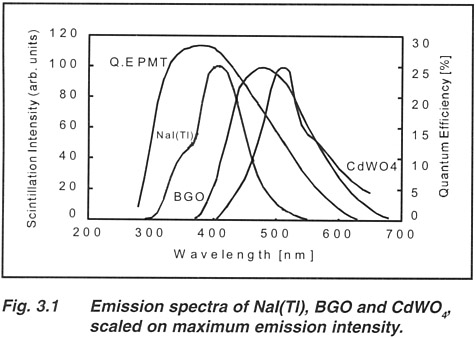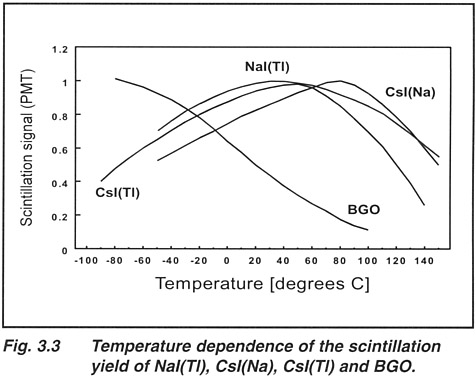 |
| Scintillator Properties Afterglow Neutron Detection Radiation Damage Emission Spectra | ||||
Temperature Influence on Scintillation Response Which Scintillator For Your Application? |
||||
|
A large number of different scintillation crystals exist for a variety of applications. Some important characteristics of scintillators are:
It is clear that for an efficient detection of g-rays, a material with a high density and high Z is required (see above). Inorganic scintillation crystals meet the requirements of stopping power and optical transparency, their densities ranging from roughly 3 to 9 g/cm3 makes them very suitable to absorb penetrating radiation (g-rays). Materials with high Z-values are used for g-ray spectroscopy at high energies (>1 MeV). Since photoelectron statistics (or electron-hole pair statistics) plays a key role in the accurate determination of the energy of the radiation, the use of scintillation materials with a high light output is preferred for all spectroscopic applications. The scintillator emission wavelength should be matched to the sensitivity of the light detection device that is used (PMT of photodiode). Scintillation light pulses (flashes) are usually characterized by a fast increase of the intensity in time (pulse rise time) followed by an exponential decrease. The decay time of a scintillator is defined by the time after which the intensity of the light pulse has returned to 1/e of its maximum value. Most scintillators are characterized by more than one decay time and usually, the effective average decay time is mentioned. The decay time is of importance for fast counting and/or timing applications. Mechanical and optical properties The most important scintillation material NaI(Tl) is hygroscopic and is only used in hermetically sealed metal containers to preserve its properties. All water soluble scintillation materials should be packaged in such a way that they are not attacked by moisture. Some scintillation crystals may easily crack or cleave under mechanical pressure whereas others, like CsI, are plastic and only will deform. In table 3.1 below, the most important aspects of commonly used scintillation materials are listed. The list is not exhaustive and new materials are developed regularly Each scintillation crystal has its own specific application. For high resolution g-ray spectroscopy, NaI(Tl), or CsI(Na) (high light output) are normally used. For high energy physics applications, the use of bismuth germanate Bi4Ge3O12 (BGO) crystals (high density and Z) improves the lateral confinement of the shower. For the detection of b-particles, CaF2(Eu) can be used instead of plastic scintillators (higher density). Below a short description of the most commonly used scintillators is presented. |
||||
| BACK TO TOP | ||||
|
(1) EFFECTIVE AGERAGE DECAY TIME FOR g-RAYS. (2) AT THE WAVELENGTH OF THE EMISSION MAXIMUM. (3) RELATIVE SCINTILLATION SIGNAL AT ROOM TEMPERATURE FOR g-RAYS WHEN . |
|||||||||||||||
| COUPLED TO A PHOTOMULTIPLIER TUBE WITH A Bi-ALKALI PHOTOCATHODE | |||||||||||||||
| BACK TO TOP | |||||||||||||||
|
To detect fast changes in transmitted intensity of X-ray beams, as e.g. in CT scanners or luggage X-ray detectors, crystals are required exhibiting extremely low afterglow. Afterglow is defined as the fraction of scintillation light still present for a certain time after the X-ray excitation stops. Afterglow originates from the presence of millisecond to even hour long decay time components. Afterglow in most halide scintillation crystals can be as high as a few percent after 3 ms. The long duration afterglow in e.g. CsI(Tl) can be a problem for many applications. Afterglow in halides is believed to be intrinsic and correlated to certain lattice defects. BGO and Cadmium Tungstate (CdWO4) crystals are examples of low afterglow scintillation materials. |
|||||||||||||||
| BACK TO TOP | |||||||||||||||
|
Neutrons do not produce ionization directly in scintillation crystals, but can be detected through their interaction with the nuclei of a suitable element. In a 6 LiI(Eu) scintillation crystal for example, neutrons interact with 6Li nuclei to produce an alpha particle and a triton (tritium nucleus), which both produce scintillation light that can be detected. For this purpose, also enriched 6Li containing glasses can be used, doped with Ce as activator. |
|||||||||||||||
| BACK TO TOP | |||||||||||||||
|
Radiation damage is defined as the change in scintillation characteristics caused by prolonged exposure to intense radiation. This damage manifests itself by a decrease of the optical transmission of a crystal which causes a decrease in pulse height and deterioration of the energy resolution of the detector. Radiation damage other than radio-activation is usually partially reversible; i.e. the absorption bands disappear slowly in time. In general, doped alkali halide scintillators such as NaI(Tl) and CsI(Tl) are rather susceptible to radiation damage. All known scintillation materials show more or less damage when exposed to large radiation doses. The effects usually can only be observed clearly in thick (> 5 cm) crystals. A material is usually called radiation hard if no measurable effects occur at a dose of 10.000 Gray. Examples of radiation hard materials are CdWO4 and GSO. |
|||||||||||||||
| BACK TO TOP | |||||||||||||||
Emission Spectra of Scintillation Crystals Each scintillation material has a characteristic emission spectrum. The shape of this emission spectrum is sometimes dependent on the type of excitation (photons / particles). This emission spectrum is of importance when choosing the optimum readout device (PMT /photodiode) and the required window material. Fig. 3.1 and 3.2 show the emission spectrum of some common scintillation materials. |
|||||||||||||||
 |
|||||||||||||||
| BACK TO TOP | |||||||||||||||
Temperature Influence on the Scintillation Response The light output (number of photons per MeV gamma) of most scintillators is a function of temperature. This is caused by the fact that in scintillation crystals, radiative transitions, responsible for the production of scintillation light. compete with non-radiative transitions (no light production). In most scintillation crystals, the light output is quenched (decreased) at higher temperatures. An example of the contrary is the fast component of BaF2 of which the emission intensity is essentially temperature independent.. |
|||||||||||||||
 |
|||||||||||||||
| The scintillation process usually involves as
well production, transport and
quenching centers. Competition between these three processes each behaving differently
with temperature, causes a complex temperature dependence of the scintillation light
output. Fig. 3.3 shows the temperature dependence of some common
scintillation crystals. For applications such as oil well logging and space research, where it is very difficult to control the temperature, this dependence should be taken into account. The doped scintillators NaI(Tl), CsI(Tl) and CsI(Na) show a distinct maximum in intensity whereas many undoped scintillators such as BGO show an increase in intensity with decreasing temperature. From Fig. 3.3 it can be seen that at above 120 oC, NaI(Tl) has the highest light output followed by CsI(Na) and CsI(Tl). For lower temperatures CsI(Na) is a good alternative to NaI(Tl) because it has better mechanical characteristics |
|||||||||||||||
 |
|||||||||||||||
| BACK TO TOP | |||||||||||||||
Which Scintillator For Your Application? When we observe Table 3.1 carefully, it is clear that none of presently known scintillation crystals possesses all the above mentioned (ideal) characteristics such as high density, fast decay etc. The choice of a certain scintillation crystal in a radiation detector depends strongly on the application. Questions such as :
are very important in this respect to determine the optimum choice. Table 3.2 presents an overview of the most commonly used scintillation materials with some of their specific applications. |
|||||||||||||||
|
|
|
||||||||||||||||||||